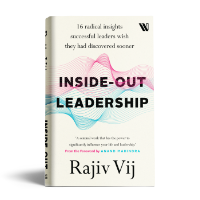“The greatest discovery of the 19th century was not in the realm of the physical sciences, but the power of the subconscious mind touched by faith. Any individual can tap into an eternal reservoir of power that will enable them to overcome any problem that may arise. All weaknesses can be overcome, bodily healing, financial independence, spiritual awakening, and prosperity beyond your wildest dreams. This is the superstructure of happiness.” – William James, Harvard Psychologist, the Father of American Psychology
In the last post, I had attempted to highlight the salient aspects of meditation as well as briefly introduced two broad techniques, namely visualization and mindfulness. In this post, I would like to expand on the visualization techniques – specifically, the theory behind them, examples of their successes, and some practical approaches.
Visualization techniques have been used to great results by many. Tiger Woods uses visualization to picture the exact trajectory of the shot he wants to make and then lets his mind relax (in a manner, get the mind out of the way) and let his body automatically perform the actions to imitate the picture. It is believed that Michelangelo painted the Sistine Chapel with a similar approach. Einstein, who supposedly demonstrated limited potential at school, suggested that his theory of relativity came less so from a deep knowledge of physics and mathematics and more so from his ability to imagine and conduct ‘thought experiments’. In an interesting research, Soviet sports scientists studied the impact of mental training, particularly including visualization, on four different groups of elite athletes before the 1980 Olympics – group 1 doing 100% physical training, group 2 – 75% physical and 25% mental training, group 3 – 50% physical and 50% mental, and group 4 – 25% physical and 75% mental training. The results were truly amazing – group 4 that did the most mental training, fared the best, while group 3 did better than 2 and so forth. Louise Hay, famous for her books on healing, rid herself of cervical cancer without any medical treatment, by primarily following a regimen of forgiveness, affirmations, nutrition and therapy. Similarly, Reiki is proven to have healed people from deadly ailments as well as supported others in achieving personal and professional growth in multiple ways.
The theory behind the power of affirmations and creative visualization techniques has four key elements – Intention, Attention, Emotion, and Faith. To appreciate the importance of intention and attention, we need to start with recognizing the fact that at its core, every thing and every being is made up of the same universal energy – called by different names in different belief systems (please feel free to read an earlier post on this theme, The Ultimate Reality). Since this energy is all-pervading, every thing in the universe is interconnected and is in a continuum that forms the collective consciousness. Our thoughts connect with this continuum via our individual subconscious. Thus, our every thought and action has the ability to influence, in however small a way, the workings of the entire universe. Similarly, every movement in the universe has an impact on our individual thoughts, actions and experiences. As we deeply visualize a desired reality, our mind sends out commensurate signals to our subconscious which passes them on to the collective consciousness – which in turn works through presenting in our life people, events, and circumstances that support the manifestation of those thoughts. Our subconscious is both a store of all thoughts, information, and memories, as well as a doorway to the collective consciousness. That’s why so many creative ideas and actions emanate just by silencing the mind and connecting with the subconscious. This aspect also lends itself to a Reiki practitioner’s ability to be a channel of the universal energy and heal others, who may even be present at long distances.
When these visualization thoughts are coupled with emotions, they get strengthened further. Emotions engage the body and mind more deeply towards actualizing the desired future state. Furthermore, what gives visualization its greatest power is presence of faith. Faith in the power of our creative minds and the universe’s desire to support us; the ability to let go of our limiting beliefs and align to the forces of nature, all along feeling safe in the knowing that the best that needs to happen will happen. This provides visualization the necessary capacity to connect with the universal consciousness and works like a strong magnet attracting all similar thoughts and experiences in the person’s life. There’s sometime the debate about whether visualization can be considered a spiritual exercise given the focus on ‘wanting’ something to manifest. I believe that visualization can be really effective only when accompanied by a deep sense of let go of our mind and its attachments – and that crucial step makes it a spiritual practice. The other important aspect of let go and faith related to these techniques is that they work only with positive thoughts – negative thoughts, of doubt and fear, act as canceling energy and deflate the power of those thoughts and emotions. Finally, visualization is the most potent when used towards the fulfillment of our highest purposes, and for the broader good of all.
In order to bring this theory into practice in our daily life, we can use this technique in any number of ways. Some people like to remind themselves of their key set of affirmations by writing them out or thinking about them several times daily. There are others who like to draw their desired future state and look at that picture often. These affirmations can be linked to well-being, self-esteem, healthy relationships, career enhancement, financial security, personal and spiritual growth and so on. Experts in this field suggest two important details for this practice – one is to imagine the desired future state in as much vivid detail as possible, and the second is to write out the affirmations about the future state in the present tense, as in – I am healthy and abundant, or I am enjoying a beautiful relationship, or I am complete, whole and perfect as I am, or I am always enjoying the moment etc. – living with these affirmations expedites the actualization of the visualized goal. Another significant area of these techniques includes working with gratitude. Many a times, we are overly focused on feeling disappointed with what we don’t have rather than being thankful for what we do have. If we spend a few moments to reflect on what all each of us has, including the uniqueness of a human body, the beauty of nature, the creative power of our minds, the opportunity to contribute meaningfully, the love and support of our relationships, the progress we made from generosity and kindness of others and so on, we begin to feel grateful for what we have and where we are. Making a list of things or people we are grateful for and remembering that frequently supports our journey of growth. Also, being thankful for what we have makes us more open to receiving further.
Finally, visualization can be extremely effective with wishes for the well-being and wholeness of something larger than ourselves – others in our family and community, a nation, the planet, or the universe. Individual affirmations not only change the attitudes and actions of that individual, but when combined with the affirmations and prayers of other like-minded people, they have the strength to bring about any kind of meaningful change. This could potentially include ending wars, eradicating poverty or slowing and reversing the trend of climate change. There are over ten billion nerve cells in the human brain, arranged in an orderly manner, and as Napoleon Hill, a great believer in the power of mind and thought, said, “This in not to take care of the physical bodies alone but to provide the infrastructure for meaningfully communicating with the collective conscious.”











 Of Well-being and Healing…
Of Well-being and Healing… Reinventing Yourself In VUCA Times
Reinventing Yourself In VUCA Times Don’t Be Too Proud Of Your Analytical Mind
Don’t Be Too Proud Of Your Analytical Mind 7 Lessons in 7 Years!
7 Lessons in 7 Years!
Good one and it helps a lot.Thank you for your great post.
Karim – Positive thinking
Hi,
You have an extremely great blog. A lot of people usually do not understand what mind power can do to one’s success Commence directing the awesome power of your mind and subconscious mind to develop the lifestyle you would like with our Mind Power training system. Get the No cost Mp3, E-Course and CD nowadays and begin directing the power of the mind and subconscious mind to create the lifestyle you need – in 7-simple measures.
really good blog.a lot of benefits.thanks a lot.
music and meditation